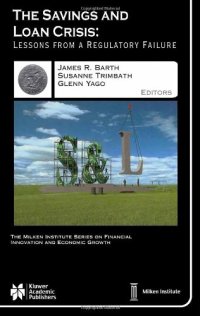
Ebook: The Savings and Loan Crisis: Lessons from a Regulatory Failure
- Tags: Finance /Banking
- Series: The Milken Institute Series on Financial Innovation and Economic Growth 5
- Year: 2004
- Publisher: Springer US
- Edition: 1
- Language: English
- pdf
Robert L. Bartley Editor Emeritus, The Wall Street Journal As this collection of essays is published, markets, regulators and society generally are sorting through the wreckage of the collapse in tech stocks at the turn of the millennium. All the more reason for an exhaustive look at our last “bubble,” if that is what we choose to call them. We haven’t had time to digest the lesson of the tech stocks and the recession that started in March 2001. After a decade, though, we’re ready to understand the savings and loan “bubble” that popped in 1989, preceding the recession that started in July 1990. For more than a half-century, we can now see clearly enough, the savings and loans were an accident waiting to happen. The best insurance for financial institutions is diversification, but the savings and loans were concentrated solely in residential financing. What’s more, they were in the business of borrowing short and lending long, accepting deposits that could be withdrawn quickly and making 20-year loans. They were further protected by Regulation Q, allowing them to pay a bit more for savings deposits than commercial banks were allowed to. In normal times, they could ride the yield curve, booking profits because long-term interest rates are generally higher than short-term ones. This world was recorded in Jimmy Stewart’s 1946 film, It’s a Wonderful Life.
The Savings and Loan Crisis: Lessons from a Regulatory Failure sets the record straight about what actually happened to our banking institutions in the 1980s. As is documented by the highly respected and diverse group of former regulators, scholars and practitioners contributing to this book, the collapse of this industry was caused by a confluence of adverse economic conditions and misguided regulatory decisions. Poorly designed deposit insurance, faulty supervision, and restrictions on investments prevented savings and loans from adapting to a changing financial marketplace. Unable to use financial innovations, savings and loans could not hedge interest rate and credit risks. These factors blocked portfolio diversification and lay at the root of the crisis. The savings and loan crisis was an accident, but it was an avoidable one. Most of the factors responsible for causing and exacerbating the industry's problems were preventable, as is made clear in this volume. This book also provides an insider's view of the transformation of the financial services industry in the United States since the 1980s: how the managers and owners make decisions about product offerings and investments; how the regulators monitor performance and enforce the rules; and how Congress and the Administration influence and are influenced by the financial services industry. Lastly, it focuses attention on the lessons that should have been learned from this difficult period in the history of U.S. banking, and that should help prevent future banking crises everywhere.